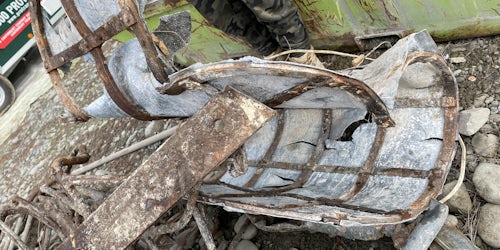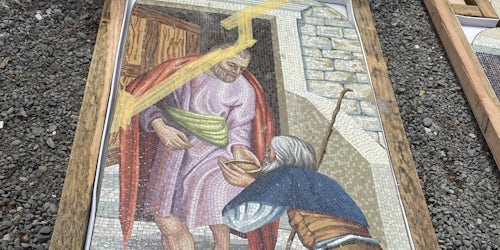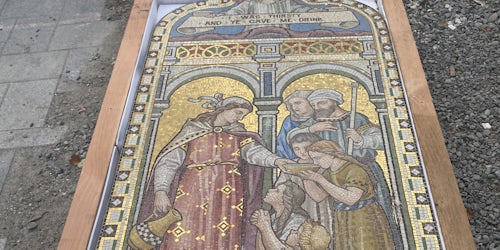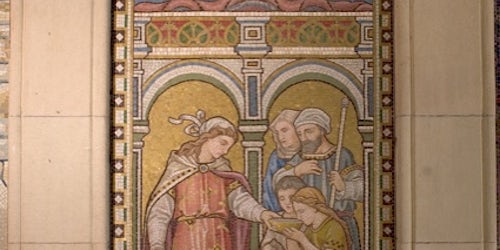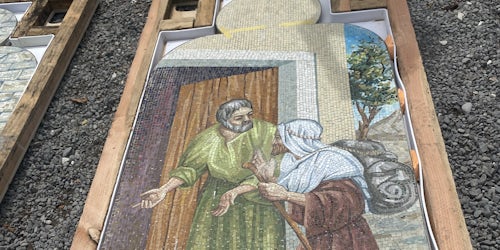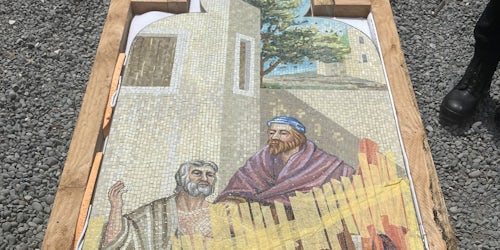Recovery of Mosaics
30 March 2023News
During 2022 I wrote an article on the beautiful mosaic panels at the west end of the Cathedral. I optimistically noted the four remaining panels had been protected and it was hoped we would also recover pieces of the three fallen panels. Following the removal of the rubble from the interior, many mosaic fragments, both large and small, were recovered but most importantly the four remaining panels have been able to be removed and are now in storage awaiting conservation.
The seven mosaic panels, were originally donated and installed between 1882 and 1970. They featured the six acts of mercy from the Gospel of Matthew, Chapter 25, verses 35-36 with a central panel that depicted Christ giving benediction.
The panels are the work of the Venetian firm Salviati and Co and were shipped complete and ready for installation, much in the manner the Cathedral’s stained-glass windows arrived from England. However, just how that was undertaken only became clear in mid-2022 when the frames of the three fallen panels were discovered in the rubble. The original frames are steel rimmed and braced with wire mesh backing to which the grout was adhered.
Despite this knowledge the team involved in the removal had to undertake a careful and extensive assessment before the removal work was undertaken. Any defects, cracks, loose areas of mortar were taped in the same way a stained glass window is treated before removal. Thus, it was with great excitement in early 2023 that the panels were safely removed from the west wall, placed in purpose built cases and able to be inspected closely at ground level. Huge credit to the team involved in removing the panels so skilfully and safely.
The first thing that strikes you when viewing them at ground level is their absolute breath-taking beauty through the subtlety of the colours of the tiny tessellated glass tiles and the brilliance and light created by the gilded glass tesserae. The detail within the art work is technically captivating. To create the level of the artistic design, execute the impressions of the fall of fabric, realism of the materials of objects, facial expressions and perspective using only tessellated tiles, is quite exquisite.
The second thing you notice when viewing the panels flat at ground level is that the perspective seems a little odd. This is because the aesthetic of the panels is one where the artists have carefully designed the works to be viewed at a certain height and at a certain distance. Thus, the creation of three-dimensional figures and objects in a two-dimensional work will often include foreshortening, consideration of the height of figures within the work, scale and distance of figures, architecture and objects to create a naturalistic perspective.
To achieve this in a realistic manner the artist also takes into consideration where the work will be viewed from. Thus, viewing these works flat or at eyelevel alters this reading.
This can be seen in the work depicting I was hungry and you fed me (right). The proportions of the figures may appear a little clumsy but viewed at the height for which they were designed any such anomaly disappears.
When considering the panel (below) I was thirsty and you gave me a drink, we can see in the image on the left that the figures appear somewhat unnaturally elongated and the depth of the scene is slightly distorted. Viewed in situ prior to the earthquake, as in the image on the right, the perspective and depth of field in the work is able to be read more realistically.
The other two panels removed depict the works of mercy I was a stranger and you invited me in (left) and I was naked and you gave me clothing (right).
These panels are part of the significant taonga being retrieved for conservation and restoration as the team now undertake work in the interior of the Cathedral.
